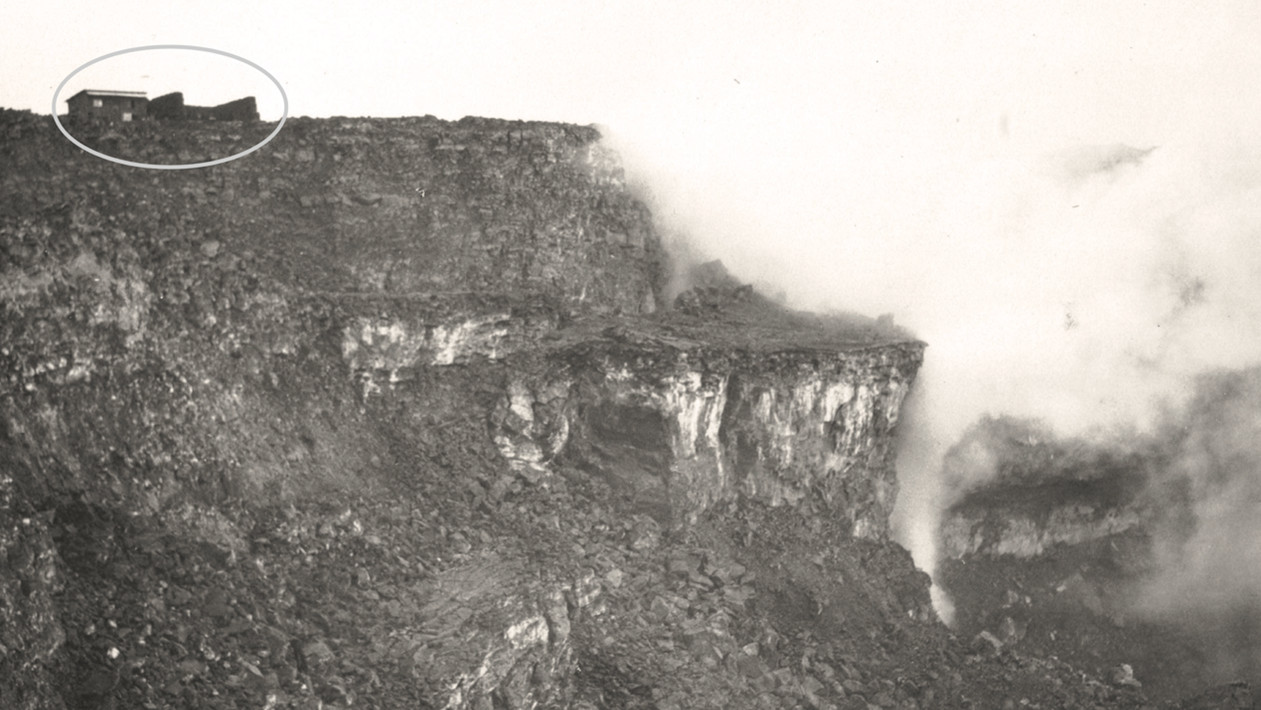(BIVN) – From this week’s Volcano Watch article, written by U.S. Geological Survey Hawaiian Volcano Observatory scientists and affiliates:
The Hawaiian Volcano Observatory (HVO) was founded in 1912. Today, over 111 years later, HVO is one of five volcano observatories supported by the U.S. Geological Survey (USGS).
HVO staff has grown from one geologist, Thomas A. Jaggar, in 1912 to more than 30 people today. This team includes scientists and specialists in geology, geophysics, geochemistry, field engineering and telemetry, information technology, administration, public communications and more. Hundreds of volunteers, students, and visiting scientists—many from the University of Hawaiʻi—have also provided valuable assistance to HVO through the years.
HVO methods of observing and analyzing data from instruments and field studies have changed dramatically since Jaggar’s time. Presently, our monitoring network consists of more than 200 sensors, including seismometers, GPS, tiltmeters, infrasound, gas detectors, and thermal/visual cameras. These sensors transmit data to HVO 24 hours a day in order to track activity and support research into how volcanoes work. Remote sensing data from instruments on aircraft, including UAS systems piloted by HVO, as well as satellites provide additional coverage.
When HVO was founded, Hawaii was not yet a state. Hawaiʻi Volcanoes National Park did not yet exist. A lake of molten lava was on the floor of Halemaʻumaʻu similar to what we’ve seen over the past three years. HVO was originally operated with support from the Massachusetts Institute of Technology (MIT) and the Hawaiian Volcano Research Association, and later managed by a series of federal agencies including the U.S. Weather Bureau, the National Park Service, and the USGS.
The USGS became the permanent administrator of HVO in 1947. Based on HVO’s success, the USGS went on to establish additional observatories to monitor and study 161 active volcanoes throughout the United States and U.S. Territories.
HVO focuses on the six active volcanoes in Hawaiʻi including two “very high threat” volcanoes—Kīlauea and Mauna Loa—and one “high threat volcano,” Hualālai. HVO also monitors active volcanoes in American Samoa.
Cascades Volcano Observatory (CVO) was authorized in 1980 following the eruption of Mount St. Helens and formally dedicated in 1982. CVO focuses on volcanoes in Washington, Oregon and Idaho. CVO is also home to the USGS Volcano Disaster Assistance Program (VDAP) which aids crisis response at volcanoes around the world.
Alaska Volcano Observatory (AVO) was founded in 1988 following the 1986 eruption of Augustine Volcano. AVO, a collaboration between the USGS, the University of Alaska Fairbanks, and the State of Alaska, focuses on volcanoes in Alaska and the Commonwealth of Northern Mariana Islands.
Yellowstone Volcano Observatory (YVO) was founded in 2001. YVO, a consortium of nine state and federal agencies, focuses on volcanic activity in the Yellowstone Plateau region and intermountain west U.S. states.
California Volcano Observatory (CalVO) was formed in 2012. CalVO, with expanded scope beyond the Long Valley Observatory (LVO) established in 1982, focuses on volcanoes in California and Nevada.
The collective knowledge, skills and experience of people at these five observatories is extensive and complementary. Staff communicate and travel between observatories in true team fashion. HVO staff help install instruments on volcanoes outside of Hawaii, and vice versa. The lead scientist for the Kīlauea Seismic Imaging Project described in a recent “Volcano Watch” article is based at CVO, and many scientists from other observatories are traveling to Hawaii to assist. Staff from all observatories assisted HVO during the 2018 Kīlauea and 2022 Mauna Loa eruptions. HVO supported eruption responses at other volcanoes such as Mount St. Helens, and will help respond to future events at other volcanoes.
Fulfilling our mission involves constant evolution and holistic future planning. As an example of preparing for possible future scenarios, HVO is participating in a virtual “tabletop exercise” led by CVO to practice responding to simulated unrest at a volcano in Oregon. And at the national scale, we are collectively developing the National Volcano Warning System (NVEWS) to ensure that volcanoes are monitored at levels commensurate to their threats.
HVO has grown and changed significantly over the past 111 years. Together with four other USGS volcano observatories established since that time, our mission continues—to assess hazards, issue warnings, and advance scientific understanding to reduce the impacts of volcanic eruptions. And to communicate the results of our work to the public, emergency managers, and the scientific community. Imua!


by Big Island Video News1:29 pm
on at
STORY SUMMARY
HAWAI‘I VOLCANOES NATIONAL PARK - U.S. Geological Survey Hawaiian Volcano Observatory scientists mark another milestone for HVO.